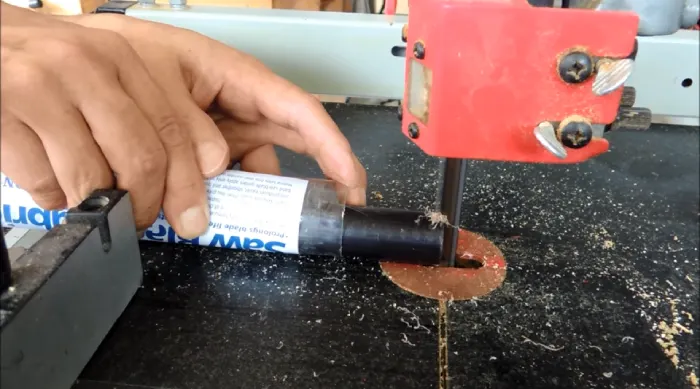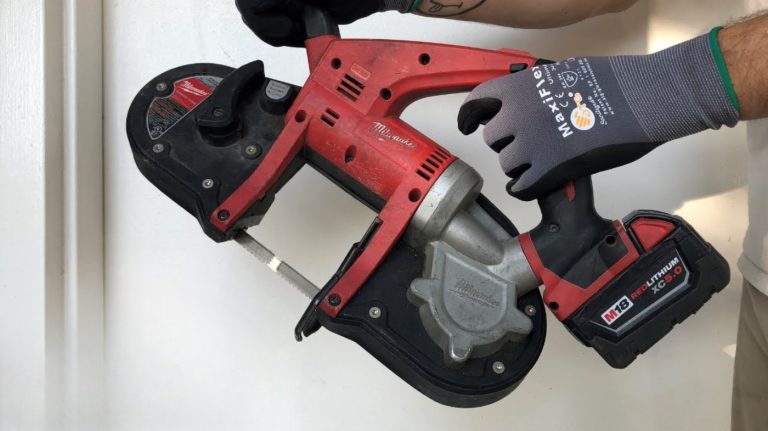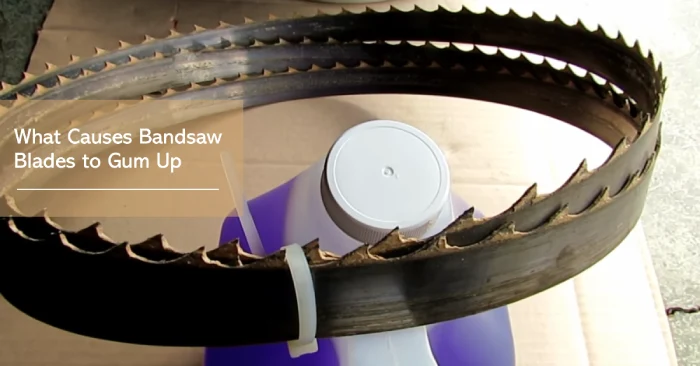Should I Use Lubricant On Bandsaw Blade: 7 Primary Reasons
Bandsaw blades are built for durability, enabling them to perform at their best for a long time. But even so, one crucial aspect of bandsaw maintenance is the use of lubricants. A simple application of lubricant can make a significant difference in the performance and durability of your blade.
Lubricating a bandsaw blade can increase its lifespan by up to 50%. Proper lubrication reduces friction, minimizes vibration, and prevents damage to the blade’s teeth and the cut material. Also, lubricant acts as a barrier, dissipates heat, and prevents the accumulation of debris and sawdust on the blade.
I’ll explain why you should lubricate your bandsaw blade, what mistakes to avoid, and what the best lubricant is. So, if you want to optimize your bandsaw’s cutting potential, keep reading to discover the secrets of effective blade lubrication.
Why Should You Use Lubricant On Bandsaw Blade: Essential Reasons

According to my study, lubricating your bandsaw blade is essential for several reasons.
- Preventing heat-induced issues
- Extended blade lifespan
- Optimizing cutting performance
- Chip management and blade cleanliness
- Noise reduction and operator comfort
- Material compatibility and rust prevention
- Maintaining blade sharpness
1. Preventing Heat-Induced Issues
One of the main issues caused by heat is the welding of chips produced during the cutting process into the blade’s gullets. This can significantly hinder the blade’s ability to cut effectively.
That’s why I recommend using a lubricant on your bandsaw blade to prevent heat-induced issues and ensure optimal functionality. Applying lubrication to the blade can act as a cooling agent, reducing the temperature and preventing chips from sticking to the blade.
This helps to mitigate the risks associated with excessive heat and ensures that the blade maintains its functionality for longer periods.
2. Extended Blade Lifespan
Excessive friction is generated when the blade cuts through harder materials without lubrication, leading to a shorter lifespan and frequent blade replacements. To ensure an extended lifespan for your bandsaw blade, you must apply lubricant to prevent wear and tear caused by cutting tough materials.
Using lubricant creates a smooth and friction-free environment for the blade, reducing heat buildup and minimizing the chances of blade failure. Additionally, lubrication helps to reduce the accumulation of debris and pitch on the blade, ensuring cleaner and more precise cuts.
3. Optimizing Cutting Performance
Proper lubrication actively contributes to the functionality of the blade. The lubricant cools down the blade, preventing overheating and potential damage. It also lubricates the teeth, reducing friction and allowing for smoother cutting.
Also, the lubricant efficiently removes any chips that may accumulate during the cutting process. This prevents chip buildup, which can lead to clogging and decreased cutting performance.
By using lubricant on your bandsaw blade, you can enhance its cutting efficiency, extend its lifespan, and easily achieve accurate cuts. So, I suggest not ignoring the importance of proper lubrication in optimizing your bandsaw blade’s performance.
4. Chip Management and Blade Cleanliness
Lubricants play a pivotal role in chip management by carrying away chips as they flow over the blade. This prevents chips from accumulating and interfering with cutting, ensuring a cleaner cutting operation.
Additionally, lubricants help reduce the likelihood of chips interfering with the blade’s teeth, which can result in a poorer-quality cut and potential damage to the blade.
5. Noise Reduction and Operator Comfort
Using lubricant on a bandsaw blade reduces noise and provides operator comfort during cutting operations. Effective lubrication contributes to a quieter cutting experience by reducing friction.
When there’s less friction, there’s less noise produced during the cutting process. This is beneficial for operators as it creates a more comfortable working environment.
The noise reduction benefits the ears and contributes to a more pleasant and focused workspace. You can concentrate better on the cutting tasks without the distraction of excessive noise. Additionally, a quieter working environment can lead to increased productivity and efficiency.
6. Material Compatibility and Rust Prevention
Lubricants act as a protective barrier against corrosion, particularly in metal-cutting bandsaws. The right lubricant selection prevents rust formation on both the blade and the cut material.
This is crucial, especially when working with sensitive metals that are prone to oxidation, ensuring the cut’s quality and the blade’s longevity.
Using a lubricant can significantly reduce the risk of rust formation, leading to blade dulling and decreased cutting efficiency. Moreover, lubricants can help preserve the integrity of the cut material, preventing corrosion or rust particles from damaging it.
7. Maintaining Blade Sharpness

To ensure the longevity and sharpness of your bandsaw blade, incorporate lubricant. It plays a crucial role in maintaining blade sharpness by preventing the accumulation of debris and chips on the blade’s teeth.
By keeping the blade edge clean, lubricants enhance cutting performance, reducing sharpening requirements and extending blade life. When debris and chips build up on the blade, they can cause friction, heat, and wear, leading to premature dulling.
Lubricating a Bandsaw Blade: What Not to Do?
In my thoughtful analysis, I’ve found certain things you should avoid when lubricating a bandsaw blade.
1. Water as a Lubricant
Using water as a lubricant for a bandsaw blade isn’t recommended due to its potential to cause rust, corrosion, and decreased effectiveness and lifespan of the blade.
Water can lead to the formation of rust and corrosion on the blade and other components, which can compromise their structural integrity and performance. Aside from this, water can cause deep pitting on the blade’s surface, leading to uneven and inefficient cutting.
Furthermore, inappropriate chip swelling can occur when water is used as a lubricant, resulting in poor chip evacuation and increased heat generation during cutting operations.
These factors combined can significantly diminish the blade’s overall effectiveness and lifespan, leading to frequent blade replacements and increased costs.
2. Incompatible Lubricants
Using incompatible lubricants can lead to gumming up of the blade, which reduces its cutting efficiency. To maintain a bandsaw blade’s cutting efficiency and effectiveness, you should avoid using general-purpose lubricants that aren’t specifically formulated for bandsaw use.
General-purpose lubricants may not have the necessary properties to withstand the high temperatures and pressures generated during bandsaw operation. These lubricants can also attract more dust and debris, further clogging the blade and reducing its performance.
3. Inconsistent Lubrication
To maintain the optimal cutting efficiency of your bandsaw blade, I recommend ensuring consistent and sufficient lubrication throughout the cutting process. Inadequate lubrication can lead to increased friction, heat, and premature wear, negatively impacting the performance and longevity of the blade.
When lubricating the bandsaw blade, check that the lubricant effectively washes over the blades upon entry and exit during the cutting operation. Inconsistent lubrication can result in areas of the blade being inadequately lubricated, leading to uneven wear and potential damage.
What is the best lubricant for bandsaw blades?

For optimal performance and long blade life, I recommend using a high-quality wax lubricant that won’t clog from wood chips or pitch. When choosing the best lubricant for your bandsaw blade, there are a few key factors to consider.
- Choosing a lubricant specifically designed for bandsaw blades is important. These lubricants are formulated to withstand the high temperatures generated during cutting and provide superior protection against wear and tear.
- Look for a lubricant that’s compatible with your specific blade material. Different blades may require different types of lubricants, so select one appropriate for your blade.
- Opt for a lubricant with a medium viscosity that’s neither too thick nor too thin. This will ensure that the lubricant effectively coats the blade without becoming too sticky or running off too quickly.
- Choose a lubricant that’s easy to apply and doesn’t leave residue behind. This will make maintenance and cleaning of the blade much easier.
Maximize Performance and Longevity of Your Bandsaw Blade: Use Lubricant as Protector
Using lubricant on a bandsaw blade is not a mere recommendation but a fundamental practice to maximize performance and longevity. From extending blade lifespan to preventing heat-induced issues and optimizing cutting performance, the benefits are clear.
By understanding the importance of lubrication and making informed choices, your bandsaw will run smoothly and make accurate cuts for years. Remember to avoid using water-based lubricants as they can cause rusting.
Instead, opt for a high-quality silicone or wax-based lubricant for optimal performance. By taking these simple steps, you can keep your bandsaw blade running smoothly and efficiently.







